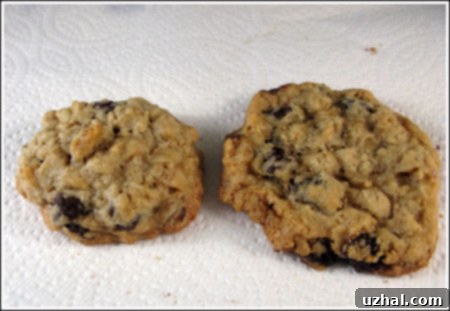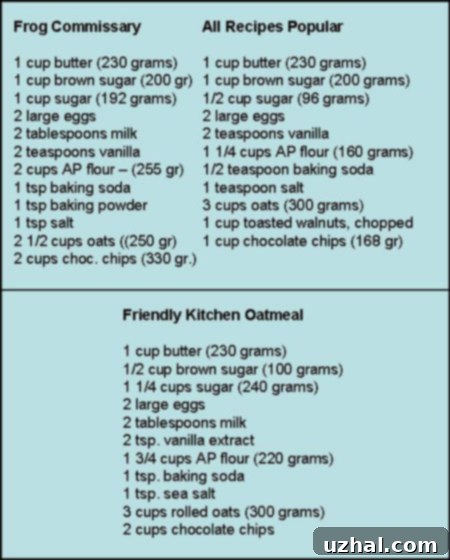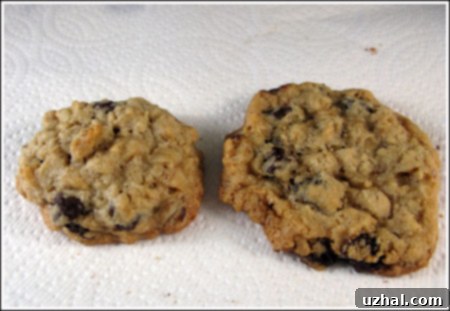The Ultimate Guide to Perfect Oatmeal Chocolate Chip Cookies: Unveiling Flour Secrets
There’s an undeniable magic in a freshly baked oatmeal chocolate chip cookie. That perfect blend of chewy oats, melting chocolate, and a hint of warmth creates a comfort food staple that transcends generations. My own quest for the quintessential oatmeal chocolate chip cookie has been a fascinating journey, rich with experimentation and discovery. This isn’t just a recipe post; it’s a deep dive into the often-underestimated power of ingredients, particularly the flour, and how it can make or break your baking endeavors. What might seem like a minor detail can profoundly impact the texture, flavor, and overall success of your beloved cookies, elevating them from merely good to truly unforgettable.
My recent baking adventure was sparked by a friend’s simple declaration of her love for oatmeal chocolate chip cookies. Inspired, I embarked on an intense baking rampage, determined to find and perfect a stellar recipe. I began by pitting two popular contenders against each other: a classic recipe from Frog Commissary and a highly-rated, 5-star recipe boasting over a thousand reviews from allrecipes.com. My initial enthusiasm, however, quickly turned to dismay. Both batches, despite meticulous measurement using a precise digital scale and measuring cups, turned out to be quite terrible.
The culprit, as I soon painfully discovered, was an unfortunate accident in my pantry: I had inadvertently acquired and used bleached all-purpose flour. The results were immediate and disappointing. My cookies were noticeably puffy, with an unappealingly dry, almost chalky texture and a somewhat bland, muted flavor. This was a far cry from the thin, crispy-edged, chewy-centered perfection I envisioned. It left me scratching my head, especially since I’ve always known that bleached flour serves a valuable purpose in certain baking applications. For instance, in recipes for delicate cakes, fluffy muffins, or tender scones, bleached flour’s lower protein content and treated structure can indeed contribute to a softer, lighter crumb. However, for the robust and chewy profile of an oatmeal chocolate chip cookie, it proved to be a critical misstep.
The Revelation: Bleached vs. Unbleached Flour in Cookies
Determined to pinpoint the exact issue, I decided to conduct a direct comparison. I managed to scrounge up a small amount of unbleached all-purpose flour from the back of my cupboard. Using the identical Frog Commissary recipe and following the same precise method, I prepared another small batch. The transformation was nothing short of miraculous. This second batch, baked under the exact same conditions but with unbleached flour, yielded cookies that spread beautifully, resulting in a thinner profile, wonderfully crispy edges, and that sought-after, satisfyingly chewy center. It was the “aha!” moment that every baker lives for, a clear demonstration of flour’s profound influence.
The visual difference was so striking that I immediately photographed the two types of cookies side-by-side. The cookie made with bleached flour was visibly thicker and denser, a testament to its inability to spread properly, while its unbleached counterpart was flatter, showcasing a more desirable texture and an inviting golden-brown hue. This direct comparison underscored a fundamental principle in baking: the type of flour you choose isn’t merely a minor detail; it’s a foundational ingredient that dictates the very structure, spread, and overall eating experience of your cookies.

So, why does unbleached flour perform so much better in recipes requiring a good chew, like oatmeal chocolate chip cookies? Unbleached flour naturally ages over time and typically retains a slightly higher protein content compared to its bleached counterpart. This allows for more robust gluten development, which is crucial for creating that desirable chewy texture and preventing cookies from becoming overly cakey or crumbly. Bleached flour, conversely, is chemically treated (often with chlorine dioxide or benzoyl peroxide) to accelerate its aging process and whiten its appearance. This treatment can also weaken the flour’s proteins, making it less ideal for recipes where strong gluten networks and a satisfying chew are the goal. It excels where tenderness and a delicate crumb are paramount, but not in hearty, chewy cookies.
The Redemption Arc: Three Winning Oatmeal Chocolate Chip Cookie Recipes
Having banished the bleached flour to the freezer, reserved strictly for its appropriate applications in cakes, I made a determined trip to the grocery store to stock up on an abundance of unbleached all-purpose flour. Armed with this newfound knowledge, I embarked on another triumphant baking marathon. My goal was not just to redeem my initial attempts, but to discover and perfect not one, but three distinct and equally delicious oatmeal chocolate chip cookie recipes that would cater to varying preferences.
- Frog Commissary Cookies (The Ultimate Crowd-Pleaser): With unbleached flour, this recipe was entirely redeemed and transformed into a genuine showstopper. These cookies strike an impeccable balance of chewiness and a delightful spread, making them universally appealing. They are reliably delicious, consistently producing a batch of golden-brown perfection that is ideal for sharing at parties, potlucks, or simply enjoying with a cup of coffee. Their straightforward charm makes them a go-to classic.
- Allrecipes.com’s 5-Star Sensation (A Celebration for Butter Lovers): This much-loved recipe truly shines when made with unbleached flour. For those who cherish the rich, creamy, and undeniably comforting flavor of butter, this is the cookie. These cookies developed an incredibly tender crumb with perfectly crispy edges and a deeply satisfying chewy center. They spread beautifully in the oven, achieving that ideal thinness while still maintaining structural integrity. The pronounced buttery notes make them an indulgent treat that truly satisfies.
- “Friendly Kitchen” Cookies (The Sturdy, Thoughtfully Less-Sweet Option): For a unique twist, I adapted a vegan curry cookie recipe I’d encountered, creatively removing the curry element and making a few other adjustments. I affectionately named them “Friendly Kitchen” cookies. These immediately stood out for their robust, thicker structure and a significantly less sweet profile. This allowed the wholesome flavors of the oats and the rich complexity of the chocolate to come forward, unmasked by excessive sugar. They offer a more substantial bite and are the perfect choice for those who prefer a more balanced sweetness or a cookie that holds up exceptionally well, perhaps even for dipping into milk.

Each of these three recipes, once perfected with the correct flour, emerged as an unequivocal winner. While my personal preference leans towards the “Friendly Kitchen” cookies for their hearty texture and balanced sweetness, I recognize and appreciate the distinct appeal of each. The allrecipes.com cookie will undoubtedly capture the hearts of butter aficionados, while the refined Frog Commissary cookie remains an excellent choice for universally pleasing any crowd. This extensive experiment vividly illustrated a fundamental truth in baking: sometimes, the most minor adjustment in an ingredient choice can lead to the most profound and delicious results.
Mastering the Art: Beyond Flour – Essential Tips for Perfect Oatmeal Chocolate Chip Cookies
While the choice of flour is indeed paramount, crafting truly exceptional oatmeal chocolate chip cookies involves attention to a few other critical elements. Let’s explore the ingredients and techniques that transform a good cookie into a truly great one, ensuring every bite is pure bliss.
Key Ingredients and Their Indispensable Roles:
- Oats: Always opt for old-fashioned rolled oats. These provide the best chewy texture and structural integrity. Avoid instant or quick-cooking oats, which tend to break down too much during baking, resulting in a mushy or gummy consistency. Steel-cut oats are generally too coarse and won’t soften adequately for cookies.
- Butter: Use unsalted butter, softened to room temperature. This is crucial for proper creaming with sugar, which incorporates air and contributes to the cookie’s lift and tender texture. If you only have salted butter, simply reduce the amount of added salt in your recipe by about a quarter teaspoon per stick of butter.
- Sugars: Most superior cookie recipes employ a blend of granulated sugar and brown sugar. Granulated sugar contributes to crispness and helps the cookies spread. Brown sugar, with its molasses content, is vital for adding moisture, chewiness, and a deeper, more complex caramelized flavor. Dark brown sugar will lend an even chewier cookie and richer taste than light brown sugar.
- Chocolate Chips: The quality of your chocolate significantly impacts the final taste. Experiment with good quality semi-sweet, milk, or dark chocolate chips. For an elevated experience, try chopping up a high-quality chocolate bar; the irregular pieces melt beautifully and create pockets of rich chocolate throughout. A mix of different types can also add wonderful dimension.
- Eggs: Use large eggs, also at room temperature. Eggs act as a binder, provide structure, and add essential moisture. Room temperature eggs emulsify much better with the creamed butter and sugar, leading to a smoother, more uniform dough.
- Vanilla Extract: A high-quality pure vanilla extract is non-negotiable. It doesn’t just add its own flavor; it enhances and rounds out all the other ingredients, brightening the overall taste profile.
- Leavening Agents (Baking Soda/Baking Powder): Many classic oatmeal chocolate chip cookie recipes primarily use baking soda. Activated by an acid (like brown sugar or sometimes buttermilk), baking soda helps cookies spread and contributes to a chewy texture. Baking powder generally provides more lift, resulting in a slightly cakier cookie. Understand your recipe’s call.
- Salt: A pinch of fine sea salt is absolutely essential. Far from just adding saltiness, it balances the sweetness, intensifies the chocolate flavor, and brightens the entire cookie, preventing it from tasting flat.
Key Baking Techniques for Achieving Cookie Perfection:
- Creaming Butter and Sugar Properly: This step is foundational. Beat the room-temperature butter with the granulated and brown sugars until the mixture is light, fluffy, and noticeably pale (typically 2-3 minutes with an electric mixer). This process incorporates tiny air pockets, which are crucial for the cookie’s final texture and structure.
- Incorporating Eggs: Add eggs one at a time, beating thoroughly after each addition until fully incorporated. This ensures the eggs are evenly dispersed and form a smooth emulsion with the butter-sugar mixture.
- Combining Dry and Wet Ingredients: Gradually add the dry ingredients to the wet mixture, mixing only until just combined. Overmixing at this stage is a common pitfall; it overdevelops the gluten, resulting in tough, dense cookies. Stop mixing as soon as no streaks of flour remain.
- Folding in Oats and Chocolate: Use a spatula to gently fold in the rolled oats and chocolate chips. This prevents crushing the oats and ensures the chocolate is evenly distributed without overworking the dough.
- Chilling the Dough – The Secret Weapon: This step is a game-changer and should not be skipped! Chilling the dough for at least 30 minutes, or ideally several hours (or even overnight), allows the flavors to meld and deepen, the flour to fully hydrate, and the butter to firm up. This prevents excessive spreading during baking, results in thicker, chewier cookies, and intensifies their flavor.
- Uniform Scooping: Use a cookie scoop to portion your dough. This ensures all cookies are of a consistent size, which promotes even baking and helps them cook at the same rate, preventing some from being burnt while others are underdone.
- Precise Baking Temperature and Time: Oven temperatures can vary, so it’s always good to know your oven. Bake until the edges of the cookies are golden brown and set, but the centers still look slightly soft or underdone. They will continue to cook and set on the hot baking sheet even after being removed from the oven.
- Proper Cooling: Allow the cookies to cool on the baking sheet for 5-10 minutes before carefully transferring them to a wire rack to cool completely. This crucial step allows them to firm up and prevents them from breaking apart when moved.
The Unbleached Advantage: A Concluding Note on Flour
Bringing our discussion full circle, the most impactful lesson from this extensive baking journey is undeniably the power of unbleached all-purpose flour for most classic, chewy cookie recipes. Its natural composition and slightly higher protein content foster a robust gluten structure, which is the key to achieving that coveted chewiness and helping cookies maintain their desired shape without becoming overly puffy, cakey, or chalky. While bleached flour remains a valuable asset for light, delicate baked goods, its chemically treated nature is often a detriment to the rustic charm and satisfying bite of a truly perfect oatmeal chocolate chip cookie. Embracing this simple switch in your pantry can profoundly elevate your baking results, ensuring every batch of cookies is a resounding, delicious success.
My culinary exploration into oatmeal chocolate chip cookies has been incredibly illuminating, reinforcing the idea that even seasoned bakers can continually refine their craft and deepen their understanding of ingredients. So, the next time a craving for these comforting treats strikes, remember the transformative power of unbleached flour and these detailed baking tips. Happy baking, and may your kitchen always be filled with the irresistible aroma of perfectly baked cookies!
